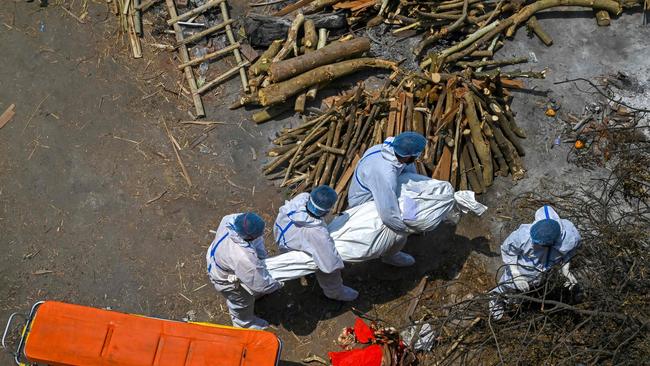Coronavirus crisis: Indians still ‘dying, dying and dying’
With oxygen still in critically short supply across the capital, hoarding and black marketeering is rife.

In the one-roomed home he shares with his wife and two children, New Delhi driver Ravi Dass gasps for air through the mask he wears day and night, desperate not to infect his kids.
“There are no hospital beds, my oxygen levels are very low. I am so worried. I don’t know what to do,” he said late on Tuesday night.
His wife also has COVID-19 and is struggling to look after her gravely ill husband and keep her children, 8 and 11, from falling ill.
Everyone is wearing a mask, the house is sanitised three times a day, but the thing they cannot do for Ravi — the family breadwinner, devoted father and husband, and my driver for six of my seven years in Delhi — is find him more air to boost his plummeting oxygen levels.
With oxygen still in critically short supply across the national capital, hoarding and black marketeering is rife. Oxygen cylinders are fetching more than $1000 on the black market. Drug treatments such as Remdesevir are going for as much as $700 for a 100ml vial, though some have found they have paid their life’s savings for spring water.
Foreign aid is trickling in. About 200 ventilators and oxygen concentrators arrived from Britain late on Tuesday, with thousands more on their way from Australia, the US, Canada, Singapore, China, Russia, the EU and the World Health Organisation.
That won’t help those dying for lack of air right now, Mumbai doctor and government adviser Zarir Udwadia told the BBC, citing “ward after ward full of patients struggling to breathe on ventilators of different forms and shapes”.
India posted yet another grim, single-day global record on Wednesday with 360,960 new cases, and 3293 recorded deaths in the previous 24 hours.
In just one week it has confirmed more than 2.6 million new COVID patients, pushing the national caseload towards 18 million. More than 200,000 people have now died. Epidemiologists predict those numbers will keep rising — to up to 500,000 reported cases a day and as many as one million COVID deaths by August.
After a slow vaccination start fuelled by hesitancy and supply shortages, Indians are queuing in their tens of thousands for a jab. Less than 10 per cent of the country’s 1.4 billion population have had their first shot. The US has lifted a ban on the export of raw materials for vaccine production to allow India to manufacture more AstraZeneca doses, and is considering sending India millions of its own unused AstraZeneca supplies.
Yet some who have received their first jabs, or even both, are now falling ill with the virulent new COVID-19 strains that have brought India to its knees. The WHO reported on Tuesday that India’s “double mutant” COVID variant, B1.617, has now been detected in more than 1200 sequences from at least 17 countries, including the UK, US and Singapore.

Ramanan Laxminarayan, director of the Centre for Disease Dynamics, Economics and Policy. says some infection of vaccinated patients “is not unexpected given the sheer force of infection at this point”.
“One shot does not fully protect. There would be some of that everywhere but I think the vaccination is working. The problem is coverage,” he told The Australian.
More worrying was the number of people whose infection was going undetected in PCR tests, and the fact younger people were now falling severely ill with the virus.
“It’s something that’s being observed on the ground a fair bit; people who test negative but have all the symptoms of COVID. It’s perplexing,” Dr Laxminarayan said. “The age and severity of illness in younger patients is also perplexing because that was not seen in the first wave. All anecdotal evidence on the ground is showing that the clinical presentation of the disease has changed and that it’s becoming more difficult to pick up.”
Across Delhi, funeral pyres are now burning day and night and even spilling out onto the city’s footpaths and car parks as crematoriums are overwhelmed.
“People are just dying, dying and dying,” said Jitender Singh Shanty, a crematorium worker who is co-ordinating more than 100 cremations a day.
“If we get more bodies then we will cremate on the road. There is no more space here. We never thought that we would see such horrible scenes.”
Having been accused of ignoring the coming catastrophe, the Indian government is now on a war footing, requisitioning medical supplies and bringing new oxygen plants online.
Where the government has failed, the people have stepped in. Volunteer groups are collecting oxygen cylinders and concentrators from those who have recovered, or died, to bring to others who might live, though — incredibly — that is proving risky for some who have been contacted by Delhi cyber police after posting online appeals. One young man in Uttar Pradesh was charged this week for asking online for oxygen for his grandfather, who later died.
Delhi’s Sikh community has been particularly hard at work, delivering food aid and even establishing a drive-through oxygen clinic on the city’s eastern fringe.
For almost a week, cars have been lining up outside the Indira Puram Gurudwara carrying passengers literally on their last breaths to make use of the free oxygen. But demand is so high that each patient is getting only 20 to 30 minutes of air, just enough to stabilise them for a trip to the next hospital in a vain search for a bed.




To join the conversation, please log in. Don't have an account? Register
Join the conversation, you are commenting as Logout